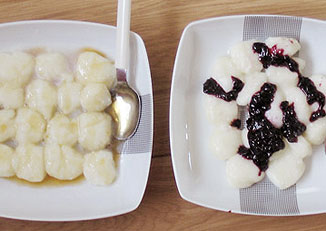Pierogi – the best guide to the most popular Polish food
An introduction to Polish pierogi
Pierogi aka pierogies is a delicious Polish food. There are few kinds of this food which differ in a filling (some authentic Polish recipes for pierogi are listed in a second part of this article). Some of these pierogi types are traditionally Polish dumplings, but let me be honest – The number of fillings is countless and limited by your imagination alone.
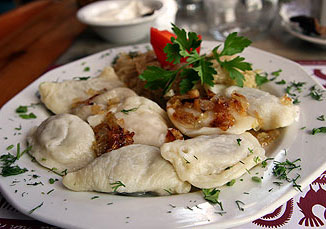
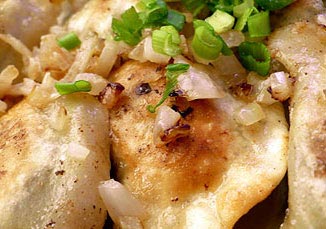
They say that the Chinese invented a lot of great things. Well, there must be some truth to it. But the homeland of pierogi is certainly one of the most beautiful countries of the European Union – Poland, situated in the geographical center of the continent. Actually, pierogi is one of the national foods of Poland. Considering the wonderful taste and versatility of this Polish food – this is not at all surprising, I would say.
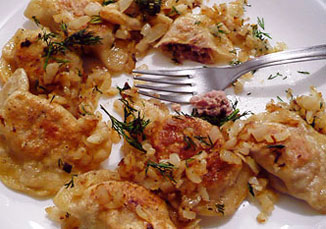
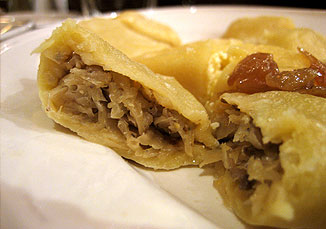
The Polish word pierogi is plural. Its singular equivalent, pieróg is not used. It is so because of a size of the dumpling - pierogi are always served two or usually more. An English word 'pierogies' is supposed to underline the 'plurality', but such a form is rather inappropriate, so I decided not to use it. Pierogi in other languages are also called perogi, perogy (in Canada), piroghi, pyrohy or Piroggen, and in various kinds and tastes are known in other cuisines of Central and Eastern Europe. A little similar food exists in Italy (ravioli, tortellini), Japan and China. Here is a list of traditional and modern Polish food prepared by TastingPoland worth to read if you want to get to know some other tastes of the Polish cuisine.
Tastes and ingredients of Polish pierogi
Pierogi are made of a thinly rolled dough with various fillings. A large number of filling types makes this Polish food a snack, spicy first course or even a dessert. Originally, in Poland the most traditional filling are: forcemeat, sauerkraut and mushrooms. A vegetarian variant of pierogi made from mushrooms and a cabbage is dished up during the Christmas Eve dinner (according to the Polish tradition - food must be meatless that day). Other kinds of pierogi, particularly popular during the summer, are sweet pierogi. Seasonal fruits are used as a filling: mainly bilberries or strawberries. Pierogi filled with a specially prepared sweetened Polish curd cheese (called a white cheese by the Poles) is also very delicious and popular.
In many regions of Poland the so-called ruskie pierogi are well known (in English: potato & cheese pierogi or ruthenian pierogi; 'Russian' is incorrect!). The name does not indicate any Russian origin, since such food is unknown in Russia. Ruskie pierogi comes from the prewar Poland's region called Red Ruthenia (today it is within a territory of Ukraine). A filling is made of cooked potatoes, white cheese and stir-fried onion. Ruskie pierogi is probably the most popular kind of pierogi in North America. But it is important to underline that this is not the most popular in Poland, although it still is very much liked.
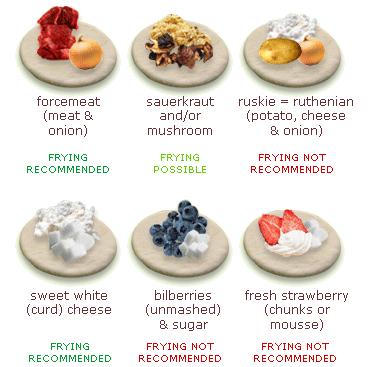
Of course there are also some peculiar kinds of a traditional Polish pierogi which have a regional character. For example in Eastern Poland pierogi with lentil filling are well-known. Locally, in the region of Lublin pierogi are filled with cheese, potatoes and dried mint, which grants to it a slight tang.
"In Poland more popular are pierogi filled with ground meat, mushrooms and cabbage, or for dessert an assortment of fruits (various berries, with either strawberries or blueberries being most common). Pierogi are usually served with melted butter and sugar, or melted butter and bacon bits. Poles traditionally dish up two types of pierogi for Christmas Eve supper. One kind is filled with sauerkraut and dried mushrooms, another – small uszka filled only with dried wild mushrooms – are dished up in clear borscht." Pierogi at Wikipedia
Uszka — pierogi-like Polish dumplings
served with red borscht
Other traditional Polish stuffed dumplings, much smaller than pierogi, are known as uszka (this is quite similar to Italian ravioli). In Poland uszka are not recognized as a kind of pierogi. The word uszka means 'little ears'. Indeed, uszka are smaller than pierogi, have a more complicated shape, and are usually filled with mushrooms or meat and never eaten on their own. This special kind of Polish food is served during Christmas Eve within a red beet clear borscht or a traditional dried mushroom borscht.
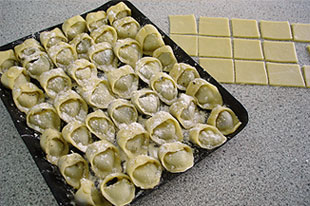
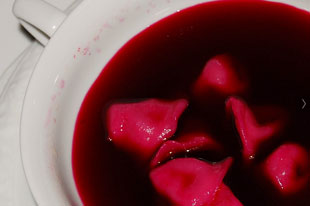
A bit of history of pierogi
How did the history of pierogi look like? There are some people who know the history of Eastern European food and believe that some kind of prototype of pierogi was imported from the Far East. Admittedly, going back a few hundred years ago, we find information about quite a similar food being eaten in China. Well, so many wonderful things come from this country that one might think pierogi are not an exception. There may be a grain of truth in that. Some say that the portotype of pierogi had come from China and travelled to Italy during the expeditions of Marco Polo. However, the whole truth is not known.
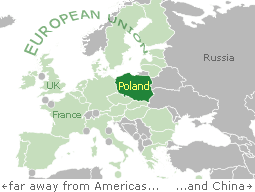
In Poland pierogi are made since the thirteenth century. The word pierogi appears for the first time in Polish literature in the second half of the 17th century - the time when some of the first Polish cookbooks were published. In this distant past pierogi were exclusively prepared on during the holiday season. The fact that each holiday had its own kind of pierogi assigned is also interesting.
Pierogi of a completely different shape and filling were served during Christmas Eve or Easter! Also some important events like a wedding were accompanied by their special kind of big pierogi. These wedding-time pierogi were called kurniki and were traditionally filled with chicken meat. Knysze were made for a mourning and served during the wake. In January – a period of Christmas caroling – some special pierogi known as koladki were baked (!), while on an occasion of a name day a sweet kind of baked pierogi was served as a dessert (called sanieżki, socznie). Sadly, these intricate traditions are no longer cultivated in Poland. Probably they are not even known nowadays. I think this is a pity. But the variety of standard, modern Polish pierogi is so huge that, nevertheless, I believe we all should feel really satisfied :)
Pierogi in United States and Canada
Nowadays Polish pierogi are quite common in United States. Pierogi were imported to North America by Polish immigrants more than one hundred years ago. This Polish food is most known in Illinois, Pennsylvania, Indiana, Michigan, New York, Connecticut, Ohio, New Jersey, Massachusetts and Wisconsin and in Canadian Manitoba, Saskatchewan, Alberta, British Columbia, Ontario. Outside North America Polish pierogi are best known in Ireland, United Kingdom, Germany, Australia and the Netherlands. Ready-made frozen pierogi are available in some other countries in the world which are aware about Polish cuisine. Since the United States, Canada or United Kingdom are among them, you can find frozen Polish pierogi in a grocery store or some Polish deli.
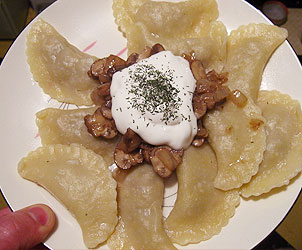

As far as I know in U.S. ruskie pierogi (a.k.a. ruthenian), with potato-cheese-onion filling, are especially popular. It is only one of many original kinds of Polish pierogi, not at all the most popular in Poland. So I would venture to say that someone who ate only ruthenian pierogi does not even know what pierogi exactly are! Believe me, pierogi with potato and cheese filling have as many supporters, as adversaries. Here is some demonstrative picture to let you know about absolutely basic kinds of Polish pierogi.
The popularity of ruskie pierogi can be explained by the fact, that the majority of ready-made, frozen pierogi is of the ruskie type (potato & cheese). But allow me to repeat this once more and say, that those who ate exclusively frozen pierogi purchased in grocery or Polish deli store lose a lot.
A few words about ready-made, frozen pierogi
In a previous part of this article I've mentioned a few advantages of pierogi, thanks to which it is worthwhile learning how to make Polish pierogi on your own, at home. To sum up what I have wrote there: (1) quite simple preparation (pierogi dough requires experience but you will become an expert more quickly than you think), (2) it is a very cheap food, (3) it can be frozen for a long time, (4) it is a universal dish - you can put inside as many things as you like.
Frozing home-made pierogi is a piece of cake and food will preserve its great taste. Incomparable with ready-made, frozen pierogi. I should emphasize that pierogi made by industrial machines are far, far away from original, traditional Polish pierogi. Usually the taste of the dough is not so bad, although it is not like it should be, either. Industrial dough has a simply less delicate, gentle taste. In a few of the worst I have tried, they tasted like flour. The dough is always too thick (on purpose). Moreover, most often frying ready-made pierogi is troublesome, since dough is prone to break down and becomes unappealing.
However, what is much more disappointing is the filling. Its taste is completely incomparable to what you can achieve at home. And I think this does not require any explanation. Would you expect that a little-known company mass producing pierogi uses the best quality products to make the filling? The truth is that when you buy frozen pierogi with forcemeat, you eat grinded animal parts, which otherwise you would never swallow. Is it possible in your country (or even in Eastern Europe) to buy strawberry pierogi stuffed with chunks of strawberry rather than a mousse? No. Mousse is omnipotent, since this is made using the worst quality of strawberries possible.
As they say frozen food is for the people. Really, I think many times it's great. And honestly – I buy it from time to time. But whenever I have some time and a willingness, I make Polish pierogi on my own.
Just one more thing. In Poland – where the marketplace of pierogi is surely bigger than in the United States, or Canada, frozen pierogi are available in many varieties, but as far as I know frozen pierogi are not highly popular. I have been told that – for example – the Polish lady of the house would not venture to serve frozen pierogi during Christmas Eve dinner. And this is not only because it would be at variance with the amazing Polish tradition, which forces Polish people to devote so much time for festive food preparation. I am quite sure, that this is because of the impoverished taste of frozen pierogi, which would not fit the taste of the guests.
Pierogi festival
In some cities, where the community of Poles was at one time notable pierogi fests are being organized. Probably the best known is Pierogi Fest in Whiting, Indiana, www.pierogifest.net. This year's fest will be held on July 23, 24, & 25. It will be the 16th annual Pierogi Festival. In Pittsburgh, Pennsylvania there is a so-called Great Pierogi Race during every Pittsburgh Pirates baseball game. In Poland annual pierogi fests are organized in Cracow (Festiwal Pierogow) and in Gdansk (Pierogi Fest).
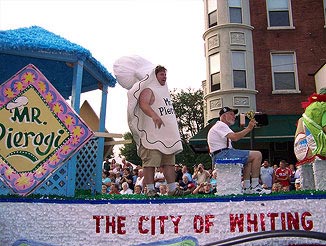
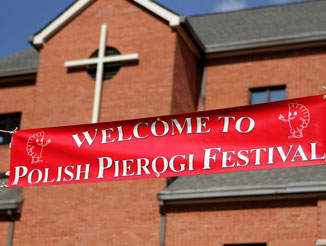
"The Pierogi Fest is an annual festival held in downtown Whiting, Indiana. Although it gets its name from the pierogi, a Polish dumpling, there are many other attractions. It lasts for 3 days on Friday, Saturday, and Sunday during late July. Although one of the main attractions is pierogi, there are many other things to do at Pierogi Fest. The main attraction is walking up and down the street tasting food from the many different food vendors, listening to live bands playing, visiting the beer garden, or riding some carnival rides." Pierogi fest at Wikipedia
11 interesting facts about Polish pierogi
Who made the largest pierogi ever and who established a Guinness record in making it the fastest? Where's the statue of pierogi? What is a pierogarnia, and what about lazy pierogi? How should we say: pierogi or pierogies?… Here comes a list of 11 most interesting facts about Polish pierogi. Enjoy! ;)
1 • Pierogi or pierogies?
The word pierogies is popular in U.S. and Canada because it underlines a 'plurality' of this well-known Polish food. However, as I have already mentioned before on Tasting Poland, this is not so appropriate since in fact the mere word 'pierogi' is already plural in the Polish language! Its grammatical singular equivalent 'pieróg' is never used by Polish people. Simply, it has a completely different meaning. Pierog, translated into English language: pyrih, is an Ukrainian pie shown on the picture below. This food can be sweet when filled with curd cheese or apples, and savory when stuffed with potatoes, cheese, groats, meat or cabbage. Sounds yummy :)
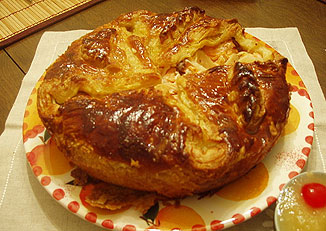
2 • What Russians have to do with pierogi?
Russians are really nice people with a great creativity, thus funny things must happen out there from time to time. Thanks to those guys we known that pierogi are not suitable for smuggling drugs. Indeed. Imagine a Russian woman from Krasnodar Krai who spent some time in hospital after she had eaten pierogi filled with hashish! You won't find any recipe for this kind of filling on Tasting Poland ;) Later it was proven that those pierogi had been prepared by a drug dealer who wanted his acquaintances to smuggle it to Petersburg. And the grandmother living with these people helped herself to pierogi in secret, not having the slightest inkling of the filling. Moreover, she had managed to regale the dog with one and he fell into a coma for all day long. What dreams he must have had!

3 • Pierogarnia in Poland
When you visit Poland remember that in many Polish towns you can come across some Polish restaurants called "pierogarnia". These are places designed to offer pierogi in dozens of tastes. This is a great thing for every tourist going to Poland. Most of the pierogarnia also sell other popular Polish food as you can see on the photo at right. It shows a typical menu from one of pierogarnia restaurants in Krakow. Notice the low prices: 1 dollar is about 3 Polish zloty.
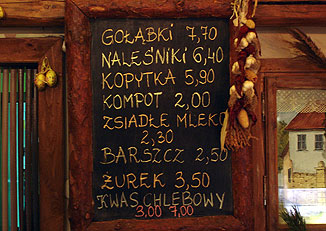
4 • Refined Polish tasters
I would do a lot for pierogi. But some Poles from beautiful Rzeszow city in eastern Poland (photo) surpassed themselves. In 2006 two guys raided a pierogarnia in Rzeszow. One of assailants had taken a handgun out and demanded a plateful of pierogi from the shop assistant. She did what they wanted, and then the men started asking for money. A brave woman reacted firmly and shouted that she was going to call police. As befits brave assailants that was enough to make them escape with no money at all. Not so bad, since they still had got away with a tray full of pierogi! Police officers found the culprits after an hour. 25 and 23 years old guys were already full up and… drunk. Were they an ordinary thugs? Actually, they must have been refined tasters!
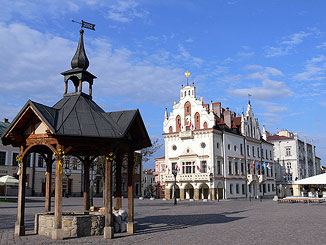
5 • Ruskie or Polish pierogi?
Ruskie pierogi, with potato + cheese + onion filling, are a very well-known traditional Polish dish. Ruskie does not mean 'Russian', rather 'Ruthenian' if we want to be precise. Ruskie pierogi come from the prewar Poland's region called Red Ruthenia. Today it lies within the borders of Ukraine. Interestingly enough, while Poles use the name 'ruthenian pierogi', on the eastern side of the Polish border some Ukrainians call the same dish 'Polish pierogi'.
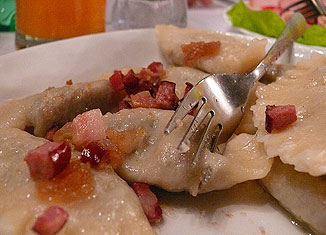
6 • The Pierogi Race
Pittsburgh Pirates baseball team organizes the so-called 'pierogi race' during their games. Four types of pierogi called Sauerkraut Saul, Cheese Chester, Jalapeno Hannah and Oliver Onion take part in the race. Well, these are four guys dressed up as pierogi. I have no idea, does it look appetizing? :) It's funny, to say the least. For sure it's a marketing campaign.

7 • Pierogi and Polish pierożki
An interesting fact about the Polish language is that most of Polish nouns have a diminutive form and an appropriate hypocorism. Most of Polish diminutives mean a thing smaller than the base word. For example simple Polish word dom (house and home) has both a diminutive form domek (small house) and a hypocorism domeczek (emotional). This is very often that the diminutive and hypocorism have a positive, emotional inclination (there are some, however, that indicate contempt). The word pierogi is not an exception. A diminutive form of pierogi is a bit more difficult to pronounce and looks like this: pierożki. You can use it in order to express your admiration for the taste of this Polish dish ;) The singular form also exists: pierożek.
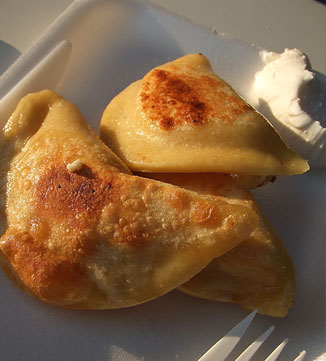
8 • Pierogi statue in Glendon
A small village Glendon, Alberta, Canada unveiled its roadside tribute to Ukrainian pyrogy in 1991. They had even appointed an Official Pyrogy Committee. Glendon's pyrogy is a huge statue of one pierogi put on the fork. The plaque states as follows:
"THE PYROGY – PYROHY. BEST MADE IN GLENDON. A European food that was brought to Western Canada in the early 19th century by the working and poor people. It originated as a boiled dumpling, and later people added whatever they desired inside, and it became a pyrogy - pyrohy, sometimes called varenyky."
Admittedly, an original idea. Actually this statue is 25-foot height, weights 6000 pounds!, and is made of fiberglass and steel. Rather not edible, I would say. But it will last forever ;)

9 • The largest pierogi ever
Since Glendon's 6 000 pound pierogi is not edible, it cannot be considered a record – I'm sorry, Canada. Probably the largest edible pierogi was made during Pierogi Fest in Whiting, Indiana. It was a 92-pounds huge dumpling. Looks disgusting, isn't it? ;)
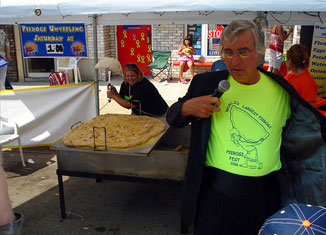
10 • Guinness record in making pierogi
The Guinness record in making pierogi belongs to ten students from a Catering School in Wroclaw, Poland. In 100 minutes they managed to make as many as 1663 dumplings! That was over 90 pounds. Their great result was officially written down in The Guinness Book of Records. After cooking and packing, the pierogi were sent to Wroclaw children's homes.
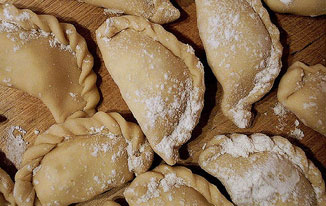
11 • Lazy pierogi
Making pierogi is a bit time-consuming. Is it possible to easily combine the taste of pierogi dough and its filling? Well, yes it is. At least in case of sweet pierogi filled with curd cheese. Here come the lazy pierogi, known in Polish as pierogi leniwe :) Lazy pierogi have quite the same shape as another Polish dish called kopytka (nice, small dumplings) but this is something completely different. Pierogi leniwe are made from curd cheese, eggs and flour, then cooked in lightly salted water. Usually lazy pierogi areserved with whipped cream, sugar & cinnamon.
